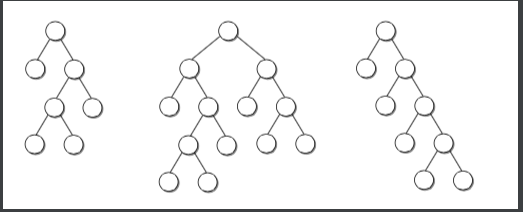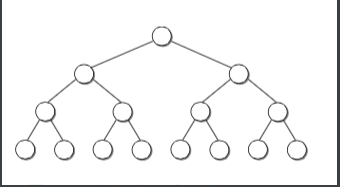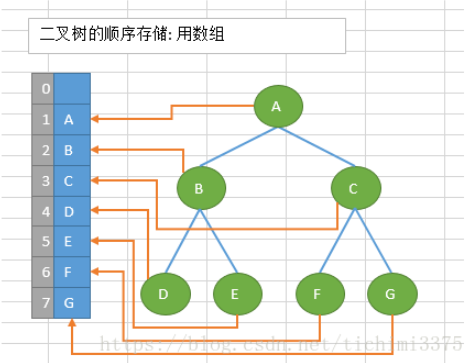Python 数据结构 树
什么是树
数是一种抽象的数据类型(ADT)或是作这种抽象数据类型的数据结构,用来模拟具有树状结构性质的数据集合,它是由n(n>1)的有限个节点和节点之间的边组成的一个有层次关系的集合。
树的组成元素:
- 根节点:树的最上层的节点,任何非空的树都有一个节点
- 路径:从起始节点到终止节点经历过的路径
- 父节点:除了根节点,每个节点的上一层边连接的节点就是它的父节点
- 子节点:每一节点由边指向的下一层节点
- 兄弟节点:同一父节点且处在同一层的节点
- 子树:每个节点包含它所有的后代组成的子树
- 叶子节点:没有子节点的节点,称为叶子节点
- 树的高度或深度:树中节点的最大层次
树具有以下的特点:
- 每个节点有零个或多个子节点;
- 没有父节点的节点称为根节点;
- 每一个非根节点有且只有一个父节点;
- 除了根节点外,每个子节点可以分为多个不相交的子树。
树的种类
- 无序树:树中的任意节点的子节点之间没有顺序关系,也称为自由树。
- 有序树:树中的任意节点的子节点之间有顺序关系。
- 二叉树:每个节点最多含有两个子树
- 完全二叉树:当一个高度为h的完美二叉树减少到h-1,并且最底层的槽被毫无间隙地从左到右填充,我们就叫它完全二叉树
- 满二叉树:如果每个内部节点(非叶子节点)都有两个子节点,就成为满二叉树
- 完美二叉树:当所有的叶子节点都在同一层就是完美二叉树,毫无间隙填充了h层
如下图所示:
满二叉树:

完美二叉树:

完全二叉树:

数的存储和表示
顺序存储:将数据结构存储在固定的数组中,所以在遍历速度上有一定的优势,同时所占用的空间比较大,是非主流二叉树。二叉树通常以链式方式存储:
如下图所示是简单的顺序存储:

链式存储: 结构采用链表存储二叉树中的数据元素,用链表建立二叉树中节点之间关系,二叉树最常用的链式存储结构是二叉链,每个节点包含三个域,分别是数据元素域data,
左还在链域Child和右孩子链域Child,与单链表头结点和不带头节点的两种情况相似,二叉链存储结构的二叉树也有带头节点和不带头结点两种。

树的常用场景
- xml,html等,那么编写这些东西的解析器的时候,不可避免用到树
- 路由协议就是使用了树的算法
- mysql数据库索引
- 文件系统的目录结构
- 所以很多经典的AI算法其实都是树搜索,此外机器学习中的decision tree也是树结构
二叉树
二叉树的基本概念
二叉树是由n(n>=0)个节点组成的集合,每个节点最多有两个子树的有序树,它或者是空集,或者是一个根和左右子树的两个不相交的二叉树组成。
二叉树的特点:
二叉树是有序树,即使是只有一个子树,也必须区分左右树。
二叉树的每个节点的的度,不能大于2.
二叉树的遍历
前序遍历:先访问根节点, 然后前序遍历左子树,再前序遍历右子树
中序遍历:中序遍历根节点的左子树,然后再访问根节点,最后遍历右子树
后序遍历:从左到右叶子节点的方式遍历访问左子树,最后访问根节点
层序遍历:从根节点从上往下逐层遍历,在同一层,按从左到右的顺序对节点逐个访问

二叉树实现方式:
# 节点定义
class Node(object):
def __init__(self, value, left_child, right_child):
self._value = value
self._left_child = left_child
self._right_child = right_child @property
def value(self):
return self._value @value.setter
def value(self, value):
self._value = self.value @property
def left_child(self):
return self._left_child @left_child.setter
def left_child(self, value):
self._left_child = value @property
def right_child(self):
return self._right_child @right_child.setter
def right_child(self, value):
self._right_child = value # 树的定义
class Tree(object):
def __init__(self, value):
self._root = Node(value, None, None) @property
def root(self):
return self._root
遍历树的代码实现:以下遍历方式亲测有效
# 递归后续遍历 def pre_order(root):
if not isinstance(root, Node):
return []
pre_order_tmp = []
if root is not None:
pre_order_tmp.append(root.value)
pre_order_tmp += pre_order(root.left_child)
pre_order_tmp += pre_order(root.right_child)
return pre_order_tmp # 非递归后续遍历
def pre_order_not_recursion(root):
if not isinstance(root, Node):
return None
stack = [root]
result = []
while stack:
node = stack.pop(-1)
if node:
if isinstance(node, Node):
result.append(node.value)
stack.append(node.right_child)
stack.append(node.left_child)
else:
result.append(node)
return result # 递归中序遍历
def middle_order(root):
if not isinstance(root, Node):
return []
middle_order_tmp = []
if root is not None:
middle_order_tmp += middle_order(root.left_child)
middle_order_tmp.append(root.value)
middle_order_tmp += middle_order(root.right_child)
return middle_order_tmp # 非递归中序遍历
def middle_order_not_recursion(root):
if not isinstance(root, Node):
return None
stack = [root.right_child, root.value, root.left_child]
result = []
while stack:
node = stack.pop(-1)
if node:
if isinstance(node, Node):
stack.append(node.left_child)
stack.append(node.value)
stack.append(node.right_child)
else:
result.append(node)
return result # 递归后续遍历
def post_order(root):
if not isinstance(root, Node):
return [] post_order_tmp=[]
if root is not None:
post_order_tmp += pre_order(root.left_child)
post_order_tmp += pre_order(root.right_child)
post_order_tmp.append(root.value)
return post_order_tmp # 非递归后续遍历
def post_order_recursion(root):
if not isinstance(root, Node):
return None
stack = [root.value, root.right_child, root.left_child]
result = []
while stack:
node = stack.pop(-1)
if node:
if isinstance(node, Node):
result.append(node.value)
stack.append(node.right_child)
stack.append(node.left_child)
else:
result.append(node)
return result # 分层遍历
def layer_order(root):
if not isinstance(root, Node):
return [] queue = [root.value, root.left_child, root.right_child]
result = []
while queue:
tmp = queue.pop(0)
if tmp:
if isinstance(tmp, Node):
queue.append(tmp.value)
queue.append(tmp.left_child)
queue.append(tmp.right_child)
else:
result.append(tmp)
return result
二叉树的其他方法:
# 递归方式计算节点个数
def node_count(root):
if not isinstance(root, Node):
return None
else:
if root:
return node_count(root.left_child)+node_count(root.right_child)+1
else:
return None # 借用分层遍历实现
def node_count_not_recursion(root):
if not isinstance(root, Node):
return None return len(layer_order(root)) # 计算二叉树深度
def tree_deep(root):
if not isinstance(root, Node):
return None if root:
return 1+max(tree_deep(root.left_child), max(root.right_child))
else:
return 0 # 非递归方式实现
def tree_deep_not_recursion(root):
if not isinstance(root, Node):
return None stack = [(root, 1)]
result = 0
while stack:
tmp_node, tmp_layer = stack.pop(0)
if tmp_node:
stack.append((tmp_node.left_child, tmp_layer+1))
stack.append((tmp_node.ritht_child, tmp_layer+1))
result = tmp_layer+1
return result # 计算第K层节点的个数
def kth_node_count(root, k):
if not isinstance(root, Node):
return None if not root or k <=0:
return 0
if k == 1:
return 1
return kth_node_count(root.left_child, k-1)+kth_node_count(root.right_child, k-1) # 计算二叉树叶子节点的个数
def leaf_account(root):
if not isinstance(root, Node):
return None if not root:
return 0
if not root.left_child and not root.right_child:
return 1
return leaf_account(root.left_child)+leaf_account(root.right_child) # 判断是否为二分查找树BST
# 判断是否为二分查找树BST,递归方式
# 二分查找树的定义搞清楚,二分查找树的中序遍历结果为递增序列
def is_bst_tree(root):
if not isinstance(root, Node):
return [] def is_asc(order):
for i in range(len(order)-1):
if order[i] > order[i+1]:
return False
return True
return is_asc(middle_order_not_recursion(root)) if __name__ == '__main__':
tree = Tree(1)
tree1 = Tree(1)
node7 = Node(5, None,None)
node6 = Node(4, None,None)
node5 = Node(3, None,None)
node4 = Node(2, None,None)
node3 = Node(1, None,None)
node2 = Node(3, node5, node6)
node1 = Node(4, node3, node4) tree.root.left_child = node1
tree.root.right_child = node2
tree1.root.left_child = node2
tree1.root.right_child = node2 print (post_order_recursion(tree.root)) print(is_bst_tree(tree.root))
print(is_bst_tree(tree1.root))
Python 数据结构 树的更多相关文章
- python数据结构树和二叉树简介
一.树的定义 树形结构是一类重要的非线性结构.树形结构是结点之间有分支,并具有层次关系的结构.它非常类似于自然界中的树.树的递归定义:树(Tree)是n(n≥0)个结点的有限集T,T为空时称为空树,否 ...
- Python数据结构--树遍历算法
''' 遍历是访问树的所有节点的过程,也可以打印它们的值. 因为所有节点都通过边(链接)连接,所以始终从根(头)节点开始. 也就是说,我们不能随机访问树中的一个节点. 这里介绍三种方式来遍历一棵树 - ...
- Python数据结构-树与树的遍历
树:是一种抽象的数据类型 树的作用:用来模拟树状结构性质的数据集合 树的特点: 每个节点有零个或者多个节点 没有父节点的节点,叫做根节点 每一个根节点有且只有一个父节点 除了根节点外,每个节点可以分成 ...
- python数据结构之树和二叉树(先序遍历、中序遍历和后序遍历)
python数据结构之树和二叉树(先序遍历.中序遍历和后序遍历) 树 树是\(n\)(\(n\ge 0\))个结点的有限集.在任意一棵非空树中,有且只有一个根结点. 二叉树是有限个元素的集合,该集合或 ...
- Python入门篇-数据结构树(tree)的遍历
Python入门篇-数据结构树(tree)的遍历 作者:尹正杰 版权声明:原创作品,谢绝转载!否则将追究法律责任. 一.遍历 迭代所有元素一遍. 二.树的遍历 对树中所有元素不重复地访问一遍,也称作扫 ...
- Python入门篇-数据结构树(tree)篇
Python入门篇-数据结构树(tree)篇 作者:尹正杰 版权声明:原创作品,谢绝转载!否则将追究法律责任. 一.树概述 1>.树的概念 非线性结构,每个元素可以有多个前躯和后继 树是n(n& ...
- Python数据结构与算法设计总结篇
1.Python数据结构篇 数据结构篇主要是阅读[Problem Solving with Python]( http://interactivepython.org/courselib/static ...
- python数据结构与算法
最近忙着准备各种笔试的东西,主要看什么数据结构啊,算法啦,balahbalah啊,以前一直就没看过这些,就挑了本简单的<啊哈算法>入门,不过里面的数据结构和算法都是用C语言写的,而自己对p ...
- Python数据结构与算法设计(总结篇)
的确,正如偶像Bruce Eckel所说,"Life is short, you need Python"! 如果你正在考虑学Java还是Python的话,那就别想了,选Pytho ...
随机推荐
- 数据结构与算法——基数排序简单Java实现
基数排序(radix sort)又称“桶子法”,在对多个正整数进行排序时可以使用.它的灵感来自于队列(Queue),它最独特的地方在于利用了数字的有穷性(阿拉伯数字只有0到9的10个). 基数排序使用 ...
- JavaBean 和 pojo 的区别
JavaBean 是一种JAVA语言写成的可重用组件.它的方法命名,构造及行为必须符合特定的约定: 这个类必须有一个公共的缺省构造函数. 这个类的属性使用getter和setter来访问,其他方法遵从 ...
- thinkphp 点击某个class提交post值,返回回来用一个弹窗插件,提示返回来要说的话
下一篇文章有讲到弹窗插件的怎么使用,自写教程 如果能帮到你,给点个赞鼓励一下 <============= 控制器 =================> public function ...
- MySQL数据库一个字段对应多个值得模糊查询和多个字段对应一个模糊查询
当一个字段想模糊查询出多个字段的时候,正常情况下一般会这么作 1 select * from a where name like 'a%' or name like 'b%' ....or ...; ...
- ELK之elasticsearch集群搭建
安装配置elasticsearch不详述 环境:主elasticsearch IP 172.16.90.11 备elasticsearch IP 172.16.90.12 修改配置文件 /etc/e ...
- 二叉苹果树|codevs5565|luoguP2015|树形DP|Elena
二叉苹果树 题目描述 有一棵苹果树,如果树枝有分叉,一定是分2叉(就是说没有只有1个儿子的结点) 这棵树共有N个结点(叶子点或者树枝分叉点),编号为1-N,树根编号一定是1. 我们用一根树枝两端连接的 ...
- JavaScript外部函数调用AngularJS的函数、$scope
x 场景: 需要在用FusionCharts画的柱状图中添加点击事件,But弹出框是Angularjs搞的,我想的是直接跳到弹出框的那个路由里,然后在弹出框的控制器中绑定数据即可: /* 点击事件 * ...
- [No000012C]WPF(4/7)类型转换器和标记扩展[译]
介绍 之前讨论了WPF的基础架构,然后逐步开始学习布局面板,转换,介绍了不同的控件,容器,UI转换等.在这篇文章中,我将讨论每个创建XAML应用前的开发人员应该了解的关于XAML最重要的东西. 标记扩 ...
- 关于nginx重新编译
nginx安装成功后,发现有一些其他模块没有编译进去,或者想额外添加一些模块,这时候就要重新编译nginx. 首先,查看之前编译的一些参数,比如: 1 2 3 4 5 [root@lmode ngin ...
- saltstack安装配置使用记录
安装 参考 http://docs.saltstack.cn/topics/installation/index.html#installation 选择对应的OS 配置 环境如下: master:1 ...
